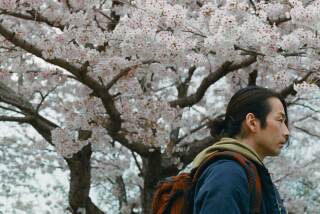Animator’s originality revealed in bold strokes
For the last 30 years, directors Hayao Miyazaki and Isao Takahata have dominated Japanese animation, and their film and TV work has been easily among the most-watched screen entertainment in Japan.
Miyazaki, if not exactly a household name here, has at least gained some recognition in the United States through his “Princess Mononoke” and the Oscar-winning “Spirited Away.”
Less clearly imprinted on the American consciousness, however, is Miyazaki’s longtime partner and co-founder of the illustrious Studio Ghibli, Isao Takahata, who will be in town this weekend as the keynote speaker Saturday at a USC symposium on “Animation and the Contemporary Japanese Imagination.” As an addendum to that symposium, the organizers have arranged screenings today and Saturday of four seminal Takahata films.
A curious and inquisitive man, Takahata’s adventurous canon spans vastly different styles and themes, seldom if ever treading the same terrain twice. The four films screening this weekend represent the divergent and myriad art of this Japanese animation legend.
His most famous work, “Grave of the Fireflies,” is a chilling portrait of firebombed Tokyo at the end of World War II. Seita and his younger sister Setsuko, both orphaned by the American bombardment, have to find ways to survive amid catastrophic destruction, famine and pervasive misery. Their homes obliterated, and abandoned by their community, the children bear witness to the very savagery that society was designed to supplant.
By contrast, “Only Yesterday” -- which will screen Saturday at the Ron Howard Screening Room at the Zemeckis Center, separate from the other films in the event -- features a 27-year-old Tokyo woman in the 1980s reflecting on 1966, the year she came of age, fell in love and went into ecstasy at the news that the Beatles were going to tour Japan. Unmarried, uninspired and dispossessed, the woman discovers this nostalgia brings her life into focus, but it raises more questions about herself than she knew she even had.
Raccoon-like animals called Tanuki, armed with an almost tribal magic, take a stand against the sprawling Tokyo suburbs in “Pom Poko.” More than a sociopolitical slap in the face to the industries of runaway urbanism, Takahata’s film brings to life a whole society of creatures trapped in the perilous divide between mankind and Mother Nature, driving that society to desperate and horrifying measures to preserve its way of life -- while maintaining a delicate comic tone throughout.
Probably the most stylized piece in the Takahata canon is “My Neighbors the Yamadas.” Rendered in Japanese ink wash and designed to look like the etchings of a child, it is a surreal look at nuclear family dynamics.
Though the narrative is very much anchored to a realistic filial unit, the storytelling technique goes the way of dreamscape logic; a wedding cake transforms into a metaphorical mountain down which the bride and groom tear in a bobsled, which in turn becomes a ship sailing through a metaphorical storm -- all while a matriarch delivers a wedding speech about the trials and tribulations of married life.
Save for a few monumental pieces, Japanese animation has become popular in the U.S. only over the last 10 years, getting a boost from the success of television franchises such as Pokemon and the cavalcade of like products that followed it. In that wake, Japanese animated films are only beginning to enjoy popular appeal. In light of this, superficial comparisons are nearly unavoidable, primarily to Disney but also to a smattering of offerings from Fox, DreamWorks, Warner Bros. and others.
Much of how each country conceives of animated films has a lot to do with the societal connotation of animated films. In this country -- and there are magnificent exceptions -- animated films are intrinsically understood to be youth entertainment, whereas in Japan, animation has avoided such a label and is avidly watched and appreciated by the public en masse.
Yet even though animation attracts adults and kids of both genders in Japan, individual films are still made for specific markets -- teenage boys or girls, young or mature adults, and for the most part don’t appeal to broader audiences. Takahata and Miyazaki’s work reaches beyond those boundaries, and their films are as commercially successful as big action films from the U.S., or even more so.
Takahata’s films have an ability to appeal to a universal audience, and he earnestly aims to reach everyone. Although his films contain mature subject material that can be construed as offensive, Takahata speaks a kind of cinematic language that is at once compelling to an 8-year-old and an 80-year old. He is not afraid to give children a glimpse of emotional gravity, despair or horror, while also enchanting them with magic, curiosity and wonder. Nor does he eschew dishing to adults youthful giddiness while engaging them in his brand of serious discourse. And in this way Takahata transcends, as does Miyazaki, the niche dilemma in which most American animation finds itself stuck.
*
Films of Isao Takahata
Today
Where: Pacific Theatre, 6433 Hollywood Blvd.
“Grave of the Fireflies,” 2 p.m.
“My Neighbors the Yamadas,”
4 p.m.
“Pom Poko,” 6:30 p.m.
Q&A; with Takahata, 8:30 p.m.
Saturday
Where: Zemeckis Center, 3131 S. Figueroa St.
“Only Yesterday,” 1:15 p.m.
Price: Free, but reservation required for Saturday screening
Info: www.annenberg.edu/anime
More to Read
Only good movies
Get the Indie Focus newsletter, Mark Olsen's weekly guide to the world of cinema.
You may occasionally receive promotional content from the Los Angeles Times.










